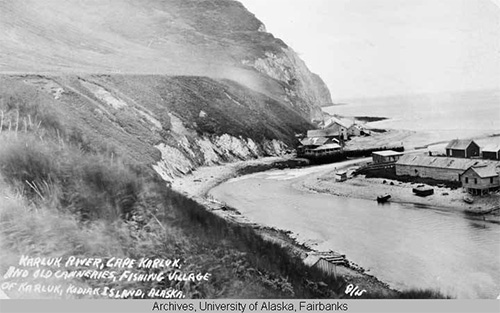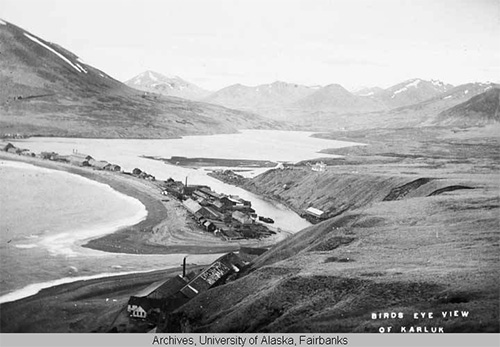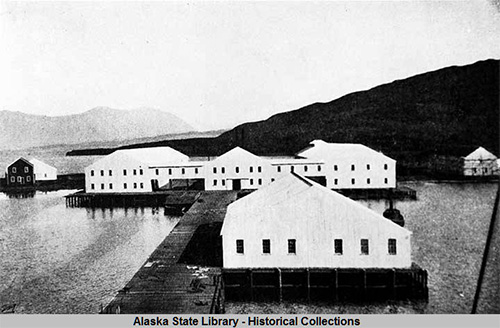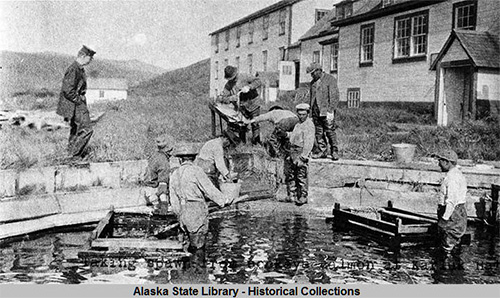
The original "Salmon Capital of the World"Karluk was Alaska's original salmon boom town long before KetchikanBy DAVE KIFFER
December 18, 2018
Today, Karluk has a population of 47 people, but in the 1890 United States Census - the first one to attempt to enumerate the approximately 30,000 people in Alaska - the small village near Larsen Bay on Kodiak Island was the third largest community in Alaska, after Juneau (1,243) and Sitka (1,190). This was at a time when "Kichkan" had only 40 residents and was much smaller than Loring (200) and Metlakatla (821).
One interesting facet of the 1890 Census was that it determined that nearly half of Karluk's population of 1,123 people was listed as "Asian." The 523 Asian residents of Karluk were the cannery workers - primarily Chinese - brought to the community to help process one of the world's largest sockeye salmon runs.
Grantham said the activity in Karluk boomed in 1889 when the Alaska Improvement Company opened another very large cannery on the beach across from the spit at the mouth of the Karluk River. Canning operations were strong through much of the 1890s and in 1898 the "improvement company" became part of the statewide Alaska Packers Association empire. Eventually, APA consolidated area operations at nearby Larsen Bay and shut down the Karluk operation, Almost immediately, the population of the village plummeted, eventually dropping into the 40s and 50s for the next several decades.
But one thing that helped the Karluk run become larger than most other runs was the unique geography of the area. Although the river itself was fairly small, it did have several tributaries and was in a wide flat area that provided ample spawning ground. It also came from Karluk Lake, a 15 mile long lake that was the largest on Kodiak Island. The Natives of the area had long taken advantage of the Karluk bounty. "Humans first arrived on Kodiak Island over 7,000 years ago and have resided along the Karluk River for at least the past 5,000 years," Gard and Bottorff wrote in 2014. " Archaeological surveys document the many sites of human habitation that existed along the river and lake. Besides the permanent residents, additional people moved to Karluk each summer from nearby winter camps to access its rich salmon resources, in particular, the indigenous Alutiiq people and their ancestor have maintained a village for millennia near the river." Perhaps the clearest indication of the importance of the area was its name. According to Gard and Bottorff, "Karluk" is derived from the Alutiiq word "iqalluk" which means "fish."
That bounty, of course, soon brought interest from outside. "The first U.S. salmon cannery in southwestern Alaska was built on Karluk Spit at the mouth of the Karluk River in 1882, and it operated without competition for the next five years,:" Gard and Bottorff reported. “The river’s enormous runs of sockeye salmon, still strong despite the previous era of Russian harvests, easily supplied the entire cannery demand of 58,800 fish in 1882. But harvests continued to increase each year and reached 1,004,500 fish in 1887. The cannery’s case pack production was shipped south 3,200 kilometers (2,000 miles) each year to San Francisco for sale and distribution. Following the commercial success of this single cannery during 1882–87, five additional canneries were built on or near Karluk Spit in the next few years, and at least five other canneries that took salmon from the Karluk River were built at further locations around Kodiak and Afognak Island (Consequently, under intense competition between the canneries, annual harvests of Karluk River sockeye salmon quickly reached several million. In fact, their total case pack during the early years of the fishery made up a major proportion of that produced from all of Alaska. In 1893, most of Karluk’s canneries were consolidated into the newly incorporated Alaska Packers Association (APA), with headquarters in San Francisco. The APA became the dominant cannery at Karluk for many decades." The seemingly endless bounty was even noted by the United States Commissioner of Fish and Fisheries.
"The Karluk River on Kadiak (sic) Island is probably the most wonderful salmon river in the world," Marshall McDonald wrote in 1894. Unfortunately, that intense interest led - as it did throughout Alaska - to overharvest. "Despite the glowing reports about Karluk’s salmon resources, the peak cannery production of 1888–94 was followed by 90 years of declining harvests and increasing debates over the cause of this reduction ," Gard and Bottorf wrote. "Governmental officials and fishery biologists sought to reverse this negative trend by imposing various regulations on the fishery and striving to understand the biological factors that controlled sockeye salmon abundance. Accordingly, a long-term program of biological research on sockeye salmon began in 1921with the installation of a weir on the Karluk River to count the number of fish that reached the spawning grounds at Karluk Lake and to gather basic data o their age, length, weight, and sex." As was the case in most of the rest of Alaska, efforts to arrest the decline of the fishery were caught up in national politics. Although biologists were clear in their contention that overfishing was the main culprit, industry leaders - led by the Alaska Packers Association - pressed for less restrictions on their operations, which were supported primarily by fish traps throughout Alaska. Mirroring runs in the rest of Alaska, the Karluk returns dropped to under 500,000 by the 1950s. The statewide crash of the salmon stock - and the closure of most of the canneries in the state - was one of the primary forces for Alaskan Statehood, and one of the first acts of the new state government in 1959 was to take control of the fishery resources from the federal government. Runs started to rebound, but then hit their absolute bottom in the early 1970s when the return to Karluk mirrored the rest of the state. Fewer than 100,000 fish returned to the Karluk Spit in those years. Since then runs have returned to the 1 million level, occasionally peaking at 1.5 million. Of course, this is decades too late for the community of Karluk, which saw its last cannery moved to nearby Larsen Bay in 1911. Still, the 40 remaining members of the community benefit from the returning sockeye runs as their ancestors have done for more than 5,000 years.
On the Web:
Contact Dave at dave@sitnews.us Dave Kiffer ©2018 Publication fee required. © Representations of fact and opinions in comments posted are solely those of the individual posters and do not represent the opinions of Sitnews.
|
|||||||




